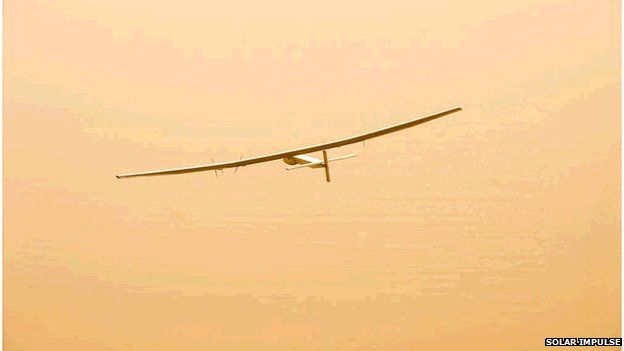
-
29 June 2015
- From the section Science & Environment

A solar-powered plane is making its second bid at a record-breaking flight across the Pacific Ocean.
Solar Impulse took off from Nagoya Airfield in Japan at 18:03 GMT on Sunday and is scheduled to land in Hawaii in approximately 120 hours.
Solar Impulse said on its website that pilot Andre Borschberg had passed the point of no return.
The team has spent nearly two months waiting for a clear weather window to cross the Pacific.
“Andre Borschberg has passed the point of no return and must now see this 5 days 5 nights flight through to the end,” Solar Impulse said on its website.
The pilot now no longer has the option to turn around and return to Japan, if the weather forecast changes.
Weeks of delay
The first attempt to fly over the ocean was cut short after a change in the forecast forced an unscheduled landing.
And another attempt to take off last Tuesday was cancelled at the last moment because of concerns about the conditions.
This time, the team will not be widely publicising the take-off until the plane is several hours into its flight, as it may need to turn back if the forecast changes.
However, if the pilot succeeds, it will be the longest-duration solo flight in aviation history, as well as the furthest distance flown by a craft that is powered only by the Sun.
The Pacific crossing is the eighth leg of Solar Impulse’s journey around the world.
But this stage has proven to be the most difficult, and has been hit by weeks of delays.
Swiss pilot and Solar Impulse co-founder Andre Borschberg, who is flying the experimental single-seater craft, was initially supposed to begin his journey to Hawaii from Nanjing in China.
But he spent weeks there, with his ground-support team, waiting for the right flying conditions to present themselves.
He finally took off on the 31 May, but a deterioration in the forecast a few hours into the mission meant that he had to divert to Japan.
The rainy season in Nagoya has meant another long wait there – but after the false start last week, meteorologists are now confident they have found a weather window to make the five-day, five-night crossing to Hawaii.
A spokesperson said that the plane would be heading straight out across the Pacific.
LEG 1: 9 March. Abu Dhabi (UAE) to Muscat (Oman) – 441km; in 13 hours and 1 minute
LEG 2: 10 March. Muscat (Oman) to Ahmedabad (India) – 1,468km; in 15 hours and 20 minutes
LEG 3: 18 March. Ahmedabad (India) to Varanasi (India) – 1,215km; in 13 hours and 15 minutes
LEG 4: 19 March. Varanasi (India) to Mandalay (Myanmar) – 1,398km; in 13 hours and 29 minutes
LEG 5: 29 March. Mandalay (Myanmar) to Chongqing (China) – 1,459km; in 20 hours and 29 minutes
LEG 6: 21 April. Chongqing (China) to Nanjing China – 1,241km; in 17 hours and 22 minutes
LEG 7: 31 May. Nanjing (China) to Kalaeloa, Hawaii (USA) – 8,200km; journey aborted, plane diverted to Nagoya, Japan
The experimental craft – which has 17,000 solar cells – is powered only by the Sun.
Once over the ocean, if it fails to soak up enough rays to fully charge its batteries and make it through the night, the pilot could be forced to bail out.
Mr Borschberg has been trained for that eventuality.
He has a dinghy and enough supplies for several days while he waits for the team to identify a vessel to go pick him up.
But, of course, the team hopes none of this will be necessary.
Mr Borschberg’s will spend the duration of the flight strapped into his seat in a cockpit that is about the same size as a telephone booth.
He will only be allowed to take 20-minute cat-naps, but says he will use yoga and meditation to make his journey more comfortable.
If this flight succeeds, the plane will continue its journey around the world, with Bertrand Piccard taking the controls for the next Pacific crossing from Hawaii to the US mainland.
The plane will then continue across North America, before attempting to fly over the Atlantic.
However, the build-up of delays could impact on the later stages. Ideally, the plane needs to cross the Atlantic before August, when the hurricane season reaches its peak.
Follow Rebecca on Twitter.
